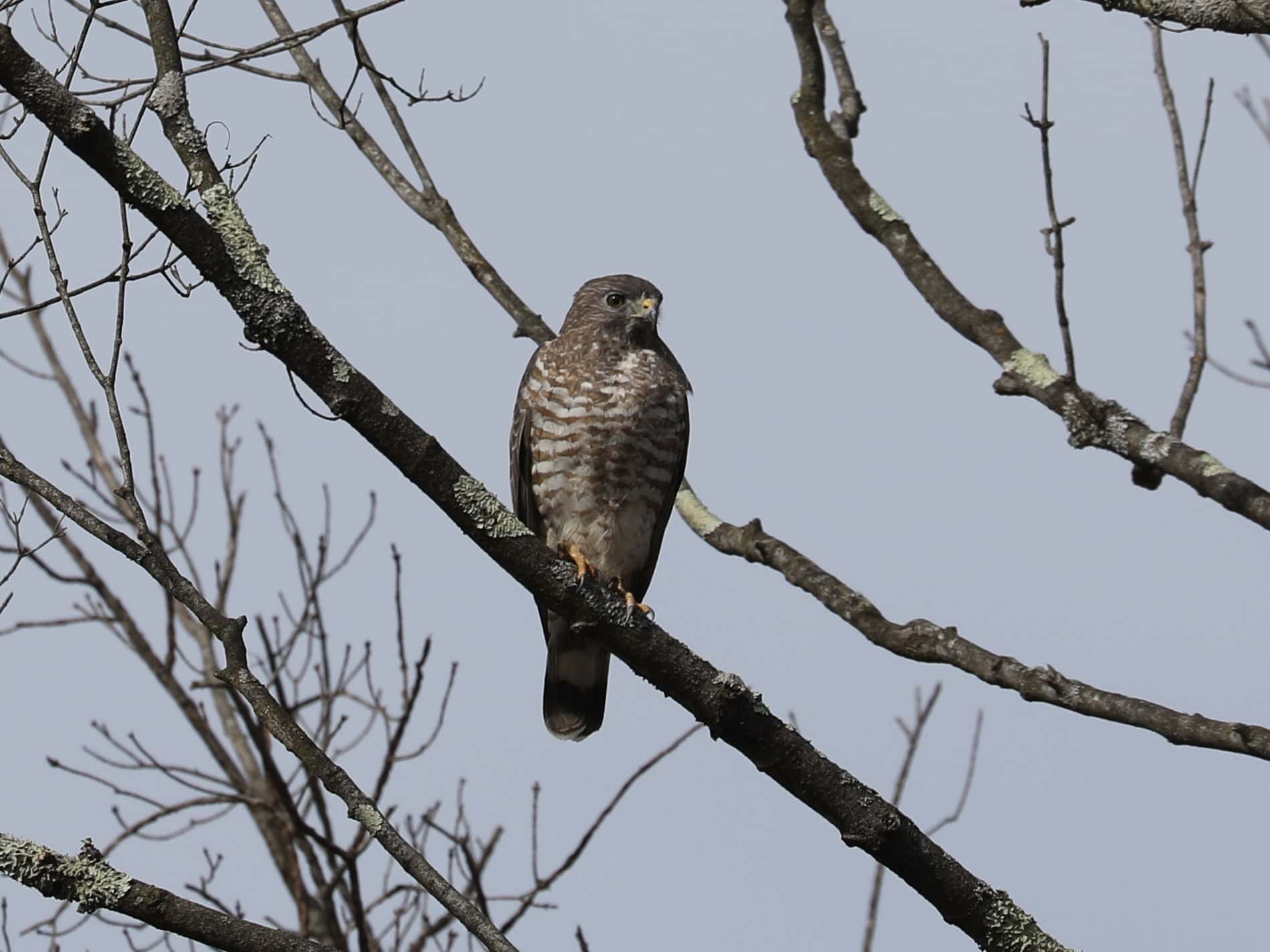Migrants Return: Broad-winged Hawks
I saw a small flock of hawks flying over the car as I drove home from work last week. Because I was driving, I couldn’t look closely enough to identify them as I drove down the highway, but I suspected they were likely Broad-winged Hawks. No other hawks in Pennsylvania are as likely to be flying in a flock, and this is the right time of year for them to return after their long migration. A few minutes later I arrived at my house, and there was a Broad-winged Hawk perched in the cherry tree next to my driveway, and another in my nextdoor neighbors’ maple. I spent the next ten minutes birdwatching in my front yard, and saw at least nine more Broad-winged Hawks flying overhead.
Broad-winged Hawks are related to Red-tailed Hawks, but they’re much smaller, only about the size of a crow. Unlike most Red-tailed Hawks, Broad-wings are long-distance migrants. They nest across most of eastern North America, then fly to northern South America, Central America, and a few Caribbean Islands (especially Cuba and Puerto Rico) for winter. As they head south during fall migration, Broad-winged Hawks are the most numerous raptor species. At Hawk Mountain Sanctuary, north of Hamburg, PA, 5 to 12 thousand of these hawks are recorded most years. If you go to Hawk Mountain in late September when the wind conditions are just right, you could see 3 to 4 thousand in a single day!
Although still abundant, Broad-winged Hawk populations have declined over the past four decades. Their nesting range has contracted, and they have disappeared as a breeding bird across parts of southeastern Pennsylvania and eastern Maryland. Population declines are likely related to loss of the large patches of contiguous forest that Broad-winged Hawks need to breed. They may also be susceptible to environmental contaminants because they tend to eat more amphibian prey than our other local hawks (toads are a favorite prey in spring). Additionally, Broad-winged Hawks may face challenges far from here in their winter range, or in important habitats they use during migration.
Spring is one of the best times of year to see Broad-winged Hawks in the Susquehanna Valley. If you see a hawk flying overhead, look for a thick band of white across the middle of the tail, a relatively dark-colored breast, and dark edges around the wings. As these hawks settle down to nest, they will spend most of their time high in trees in dense forest canopies. Once nesting starts, they’ll be hard to see until they take to the skies again to migrate in September.
Migrants Return: Broad-winged Hawks
I saw a small flock of hawks flying over the car as I drove home from work last week. Because I was driving, I couldn’t look closely enough to identify them as I drove down the highway, but I suspected they were likely Broad-winged Hawks. No other hawks in Pennsylvania are as likely to be flying in a flock, and this is the right time of year for them to return after their long migration. A few minutes later I arrived at my house, and there was a Broad-winged Hawk perched in the cherry tree next to my driveway, and another in my nextdoor neighbors’ maple. I spent the next ten minutes birdwatching in my front yard, and saw at least nine more Broad-winged Hawks flying overhead.
Broad-winged Hawks are related to Red-tailed Hawks, but they’re much smaller, only about the size of a crow. Unlike most Red-tailed Hawks, Broad-wings are long-distance migrants. They nest across most of eastern North America, then fly to northern South America, Central America, and a few Caribbean Islands (especially Cuba and Puerto Rico) for winter. As they head south during fall migration, Broad-winged Hawks are the most numerous raptor species. At Hawk Mountain Sanctuary, north of Hamburg, PA, 5 to 12 thousand of these hawks are recorded most years. If you go to Hawk Mountain in late September when the wind conditions are just right, you could see 3 to 4 thousand in a single day!
Although still abundant, Broad-winged Hawk populations have declined over the past four decades. Their nesting range has contracted, and they have disappeared as a breeding bird across parts of southeastern Pennsylvania and eastern Maryland. Population declines are likely related to loss of the large patches of contiguous forest that Broad-winged Hawks need to breed. They may also be susceptible to environmental contaminants because they tend to eat more amphibian prey than our other local hawks (toads are a favorite prey in spring). Additionally, Broad-winged Hawks may face challenges far from here in their winter range, or in important habitats they use during migration.
Spring is one of the best times of year to see Broad-winged Hawks in the Susquehanna Valley. If you see a hawk flying overhead, look for a thick band of white across the middle of the tail, a relatively dark-colored breast, and dark edges around the wings. As these hawks settle down to nest, they will spend most of their time high in trees in dense forest canopies. Once nesting starts, they’ll be hard to see until they take to the skies again to migrate in September.
About The Author
Dan Hinnebusch is the Ornithologist for Wild Birds Unlimited. Click to learn more.





